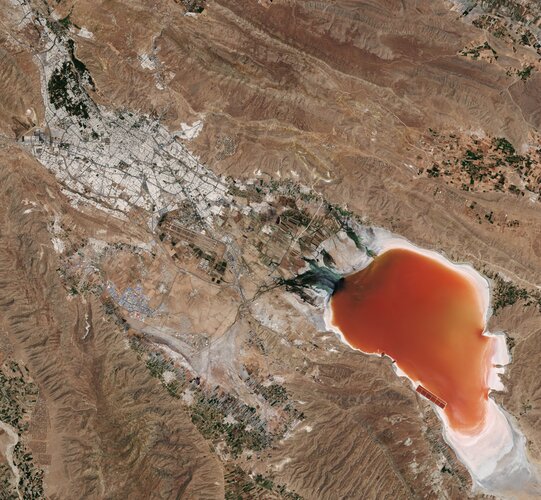
Copernical Team
SpaceX Inspiration4 mission sent 4 people with minimal training into orbit
 Just after 8 p.m. EST on Sept. 15, 2021, the next batch of space tourists lifted off aboard a SpaceX rocket. Organized and funded by entrepreneur Jared Isaacman, the Inspiration4 mission touts itself as "the first all-civilian mission to orbit" and represents a new type of space tourism.
The four crew members are not the first space tourists this year. In the past few months, the world wit
Just after 8 p.m. EST on Sept. 15, 2021, the next batch of space tourists lifted off aboard a SpaceX rocket. Organized and funded by entrepreneur Jared Isaacman, the Inspiration4 mission touts itself as "the first all-civilian mission to orbit" and represents a new type of space tourism.
The four crew members are not the first space tourists this year. In the past few months, the world wit Soundblasting a satellite: Time-lapse of testing

Verifying that a satellite will resist the sheer noise of the rocket launching it into orbit is a very important test that every mission must successfully pass.
"Typically satellites are tested inside purpose-built reverberant chambers, such as ESTEC's own Large European Acoustic Facility sometimes described as the largest and most powerful sound system in Europe," explains ESA test facility expert Steffen Scharfenberg, overseeing the test campaign together with ESA mechanical engineer Ivan Ngan. A very powerful noise generation system produces a uniform noise field thanks to the reverberation on the thick concrete walls of the chamber.
ESA has initiated a working group comprising of European spacecraft testing entities, industries and academics to study an alternative method, in which the satellite is surrounded by less powerful noise generators but these are placed very close all around the satellite. This method is called the Direct Field Acoustic Noise Test.
This technique is already in use in several locations but there is not yet much experience of it in Europe. Accordingly ESA has just completed a test campaign where the classic method and the new method have been used on a small satellite to compare their results.
Back to School with ESA astronaut Matthias Maurer
 Video:
00:04:32
Video:
00:04:32
Kick off the 2021-22 school year with ESA school projects. ESA astronaut Matthias Maurer introduces the wide range of space-based STEM projects available to primary and secondary students: Moon Camp, Climate Detectives, Astro Pi, CanSat and Mission X.
Week in images: 13 - 17 September 2021

Week in images: 13 - 17 September 2021
Discover our week through the lens
Earth from Space: Maharloo Lake

Maharloo Lake, a seasonal salt lake in Iran, is featured in this image captured by the Copernicus Sentinel-2 mission.
'Happy' SpaceX tourist crew spend first day whizzing around Earth

SpaceX's all-civilian Inspiration4 crew spent their first day in orbit conducting scientific research and talking to children at a pediatric cancer hospital, after blasting off on their pioneering mission from Cape Canaveral the night before.
St Jude tweeted its patients got to speak with the four American space tourists, "asking the questions we all want to know like 'are there cows on the Moon?'"
Billionaire Jared Isaacman, who chartered the flight, is trying to raise $200 million for the research facility.
Inspiration4 is the first orbital spaceflight with only private citizens aboard.
Earlier, Elon Musk's company tweeted that the four were "healthy" and "happy," had completed their first round of scientific research, and enjoyed a couple of meals.
Musk himself tweeted that he had personally spoken with the crew and "all is well.
Modern snakes evolved from a few survivors of dino-killing asteroid
 A new study suggests that all living snakes evolved from a handful of species that survived the giant asteroid impact that wiped out the dinosaurs and most other living things at the end of the Cretaceous. The authors say that this devastating extinction event was a form of 'creative destruction' that allowed snakes to diversify into new niches, previously filled by their competitors.
The
A new study suggests that all living snakes evolved from a handful of species that survived the giant asteroid impact that wiped out the dinosaurs and most other living things at the end of the Cretaceous. The authors say that this devastating extinction event was a form of 'creative destruction' that allowed snakes to diversify into new niches, previously filled by their competitors.
The Russian actress says 'too late' to fear ISS launch
 Russian actress Yulia Peresild said Thursday it was "too late" for fear ahead of her launch into space, as Moscow races against Hollywood to film the first movie in orbit.
Russia's space agency Roscosmos is dispatching the 36-year-old screen star next month to the International Space Station (ISS) along with director Klim Shipenko, 38, in the race against time to beat a parallel US project.
Russian actress Yulia Peresild said Thursday it was "too late" for fear ahead of her launch into space, as Moscow races against Hollywood to film the first movie in orbit.
Russia's space agency Roscosmos is dispatching the 36-year-old screen star next month to the International Space Station (ISS) along with director Klim Shipenko, 38, in the race against time to beat a parallel US project. Inspiration4 crew circles the Earth on mission's first full day
 The crew of the first all-private orbital space mission has spent Thursday, the first full day of the mission, circling the Earth every 90 minutes at over 17,000 mph.
SpaceX reported the Crew Dragon Resilience capsule with four civilians inside was traveling 363 miles high over Asia as of mid-morning, quickly moving over the massive continent. The altitude is a full hundred miles higher
The crew of the first all-private orbital space mission has spent Thursday, the first full day of the mission, circling the Earth every 90 minutes at over 17,000 mph.
SpaceX reported the Crew Dragon Resilience capsule with four civilians inside was traveling 363 miles high over Asia as of mid-morning, quickly moving over the massive continent. The altitude is a full hundred miles higher Men may sleep worse on nights during the first half of the lunar cycle
 Men's sleep may be more powerfully influenced by the lunar cycle than women's, according to a new study from Uppsala University, now published in the journal Science of the Total Environment.
Previous studies have produced somewhat conflicting results on the association between the lunar cycle and sleep, with some reporting an association whereas others did not. There are several possible
Men's sleep may be more powerfully influenced by the lunar cycle than women's, according to a new study from Uppsala University, now published in the journal Science of the Total Environment.
Previous studies have produced somewhat conflicting results on the association between the lunar cycle and sleep, with some reporting an association whereas others did not. There are several possible 
